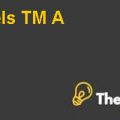Measurement and Cost Estimating Case Study Solution
Sections of Bill of Quantity (BOQ)
The bill of quantity consist of six main sections, each section is briefly explained below.
Item Number in Bill of Quantity (BOQ)
It is not easy to memorize each and every item used in the project and entered in the bill of quantity, therefore we assign every item a particular item number which makes easy to recall the item at the time of need.
Item Description in Bill of Quantity (BOQ)
In this section a detailed description of each item is given this this the most important part of and considered as the heart of bill of quantity (BOQ), this part is of great importance a requires special attention because if a single word is misprint or miss typed it may result as a big financial loss and many companies has suffered from this mistake during various projects.
Unit of measurement in Bill of Quantity (BOQ)
This section is also of great importance while filling a tender for a project because the unit in which you prepare your bill of quantity can vary the overall project cost lets understand this by an example suppose a vendor gives you the rate of tiles in terms of square feet and the other tender gives you the rate of tiles in terms of square meter so there is a measurable difference between both units and you have to kept this thing in mind while analyzing the project budget given by each vendor.
Quantity of each item in Bill of Quantity (BOQ)
As indicated by name this section deals with the quantity of each item and material required in the project.
Rate of every item in Bill of Quantity (BOQ)
This section is quite important and requires patience while reading the rate of each item and carefully analyze that the rate of each specific item is with its accessories or without accessories.
Total amount in Bill of Quantity (BOQ)
This section contains the total amount of all the items and materials with their actual quantity the total amount of each item is calculated as (Total amount= Total quantity*Price of each unit) the total amount for all the items is added at last to compute the overall amount of each and every item.
Items of work to be measured and billed in detail
Bill No-1 (Substructure)
The take-off list for substructure containing all the steps to be include in sequential manner .Take-off list
- Site preparation removal of top soil. 5- Retain excavated material on the site.
- Retain excavated top soil in temp soil 6- Concrete in foundations.
Heap. 7- Brick work in skins of hollow wall.
- Excavating foundations. 8- Block work in skins of hollow wall.
- Disposal of the excavated material 9- Forming cavity.
Of the site. 10- Insitu concrete filling to hollow walls.
11- Imported filling hardware bed 150 mm
thick.
12- Damp proof membrane.
13- Filling obtained from evacuated material.
14- Insitu concrete slab 150 mm thick.
15- Cavity insulation.
- Damp proof course.
- Filling the top soil.
Table 1 Bill No 1: Substructure
Code |
Item Description |
Quantity |
Unit |
Rate |
Amount |
|||||||||||||||
| 1.1.1
1.1.1.1
1.1.1.2
1.1.1.3
1.1.1.4
1.1.1.5
1.1.1.6
1.1.1.7
1.1.1.8
1.1.1.9
|
Substructure Foundations
|
18
13
5
2
5
28
5
24
3
2
68
|
m³
m³
m³
m³
m³
m²
m²
m²
m²
m²
m²
|
6.46
27.73
113.48
100
30
13.50
61.00
55.00
47.52
1.80
3.00 |
116.28
360.49
567.40
200
150
378.00
305.00
1320
142.68
52.28
204.00
|
Total Bill of Substructure
3,796.05
Table 2 Bill No: 2 (Superstructure)
Code |
Item Description |
Quantity |
Unit |
Rate |
Amount |
| 2.1.1
2.1.1.1
2.1.1.2
2.1.1.3
2.1.1.4
2.1.1.5
2.1.1.6
2.1.1.7
2.1.1.8
|
Super-Structure
A block walls 150 mm thick In cement mortar (1:3)
Concrete column C30 material.
Reinforced concrete slab 125mm thick.
Concrete Slab
Steel rod 16 mm in diameter
Timber beams for columns
Cantilever beam for concrete slab support
Doors with timber frame and
|
210.0
3.0
12.0
34.5
289.3
90
1218
4.0 |
m²
m³
mᵌ
m³
m³
m²
kg
No
|
260
6000
6000
6500
50
50
35
2300 |
54,6000
18,000
72,000
224,250
14,250
45,000
42,630
92,000 |
Total bill of Super-Structure
1054,130
Table 3 Bill No: 3 (Finishes)
Code |
Item Description |
Quantity |
Unit |
Rate |
Amount |
| 3.1.1
3.1.1.1 3.1.1.2 3.1.1.3 3.1.1.4 3.1.1.5 3.1.1.6
3.1.1.7 3.1.1.8
3.1.1.9
3.1.1.10 |
Finishes
Electric cable for wiring P.V.C pipe 12mm Fitting for fluorescent Security lights Electric sockets Control switches and ceiling fan Distribution box Electrical Connection points for lights and fans. PVC pipes for bathroom And kitchen Tank and water supply connection |
7 4 8 8 16 8
9 15
21
3 |
Item
Item
No
No
No
No
No
No
Item
Item |
7000 1200 250 250 100 700
650 230
410
335 |
49000 4800 2000 2000 1600 5600
5850 3450
8160
1005 |
Total bill of finishes
83,465
Bill No: 4 (Provisional-Sum)
A provisional sum is defined as the actual cost estimated by the cost estimator consultant it is not necessary that the calculated provisional sum fits 100 % on the proposed structure there is always a range of tolerance because of factors involve in construction project. The provisional sum is the sum of total individual bill of quantity in our case the provisional-sum bill of quantity is the sum of sub-structure, super-structure and internal finishes bill of quantity, summing all the above quantities in order to get the provisional sum.
Total bill of sub-structure = 3,796.06
Total bill of super-structure= 1054,130
Total bill of finishes = 83,465
Total bill (Provisional-Sum) = 1141,391.05
Conclusion
The report deals with step by step working of a rectangular house consist of two rooms the bedroom and living room, first of all the take-off is calculated lets revise again what is take-off. “Quantity take-off is a process in which calculations of building material and labor needed to complete a project is made, the calculation is made by experienced professional during the preconstruction phase, these estimators has developed many techniques in order to enhance quality work, the most important part to carry all the construction process smoothly with the given time.The quantity take-off is off great importance because it helps to measure the cost of various equipment and cost of labor in correspondence to material quantity and time. After that the bill of quantity is prepared for each section the sub-structure section, super-structure section and finishes after that the bill of quantity of all the sections is added in order to get the provisional sum of the whole project. The bill of quantity is the most important part of a project phase under process because it helps us to plan the cost of the overall project include labor, material and equipment charges used in the project, it also help us to design a work flow for construction planning step by step and moreover it also help us to manage material scheduling including the overall material requirement including the waste. The bill of quantity provides project contract administration, project tender comparison and controls the cost variation including the overhead and risk factor..........
This is just a sample partical work. Please place the order on the website to get your own originally done case solution.












